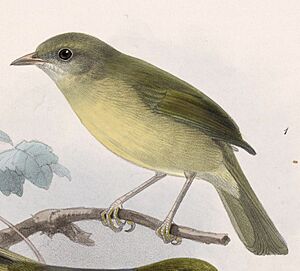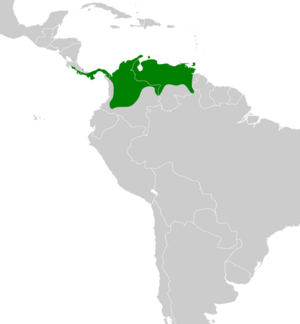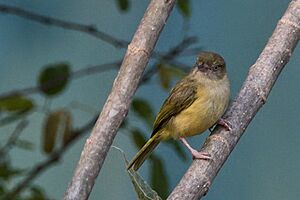Scrub greenlet facts for kids
Quick facts for kids Scrub greenlet |
|
|---|---|
 |
|
| Conservation status | |
| Scientific classification | |
| Genus: |
Hylophilus
|
| Species: |
flavipes
|
 |
|
The scrub greenlet or scrub vireo (Hylophilus flavipes) is a small passerine bird. It is part of the vireo family. These birds live in countries like Costa Rica, Panama, Colombia, Venezuela, and Tobago. You can find them in the southern parts of Central America and the northern areas of South America.
Contents
Where Scrub Greenlets Live
Scrub greenlets like to live in places where forests meet open areas. They also enjoy savannas (grassy plains with scattered trees) and light woodlands. They usually stay in lower areas, close to sea level.
What Scrub Greenlets Look Like
An adult scrub greenlet is about 11.5 centimeters (about 4.5 inches) long. It weighs around 13 grams (about half an ounce). Their upper body is mostly green. Their wings and rump (the lower back) are brighter green. Their head is olive-brown. They have a faint yellowish ring around their eyes. Their belly and chest are yellow. The bill is mostly dark, and their legs are pale.
Both male and female scrub greenlets look similar. They are often seen together in pairs. Their call sounds like a long series of notes, like weary-weary-weary-weary. They also make churrs and squeaks.
Behavior and Life Cycle
Scrub greenlets build a deep, cup-shaped nest. They hang it from a tree branch. A female scrub greenlet usually lays three white eggs. These eggs have brown marks on them.
These birds are known to hang upside down to find food. They eat insects and spiders from the middle and upper parts of tree leaves. They also eat berries, especially before they migrate.
Scrub greenlets sometimes join groups of different bird species. These "mixed feeding flocks" help birds find food more easily. They also offer protection from predators. Scientists are still studying why these mixed flocks happen.
The number of scrub greenlets in the world is not known exactly. However, their population is not thought to be shrinking. Because of this, they are listed as a species of "Least Concern." This means they are not currently at risk of disappearing.
Types of Scrub Greenlets
There are seven different types, or subspecies, of scrub greenlets. They are grouped into three main areas: Central America, South America, and Tobago.
Central American Scrub Greenlets
This group is known as the scrub greenlet (yellow-green). These birds have dark yellow underparts and bright green upperparts. They include two subspecies:
- Hylophilus flavipes viridiflavus: These are found in southwestern Costa Rica, Panama, and along the Pacific coast.
- Hylophilus flavipes xuthus: These are similar but less yellow. They have darker green upperparts and a heavier bill. They live on Coiba Island.
South American Scrub Greenlets
This group is known as the scrub greenlet (scrub). It includes four subspecies:
- H. flavipes: Found in northern and central Colombia. They are dull olive green with a slightly brighter rump. Their chin and chest are whitish-gray.
- H. flavipes melleus: Found in northern Colombia. They have a darker crown and back, with less yellow on their underparts.
- H. flavipes galbanus: Found in northern and eastern Colombia. They have a whiter belly and white eyes.
- H. flavipes acuticaudus: Found in Northern Venezuela. They are duller in color compared to the main subspecies.
Tobago Scrub Greenlets
This group includes one subspecies:
- H. insularis: Found on the island of Tobago. This type is larger than the other scrub greenlets.



